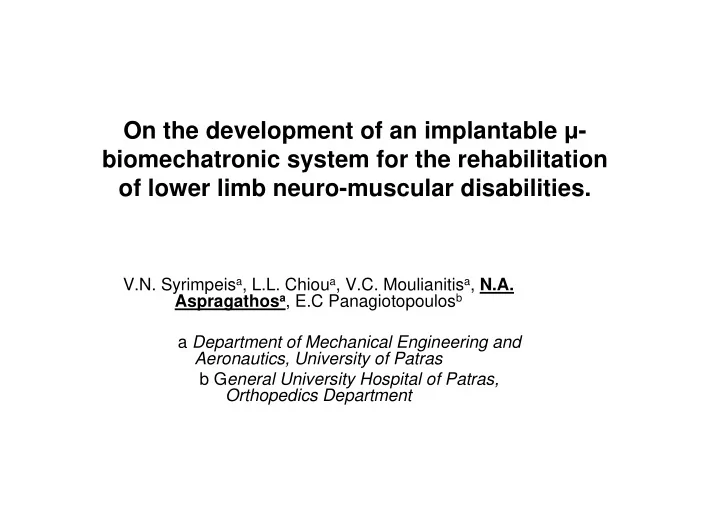

On the development of an implantable � - biomechatronic system for the rehabilitation of lower limb neuro-muscular disabilities. V.N. Syrimpeis a , L.L. Chiou a , V.C. Moulianitis a , N.A. Aspragathos a , E.C Panagiotopoulos b a Department of Mechanical Engineering and Aeronautics, University of Patras b G eneral University Hospital of Patras, Orthopedics Department
Outline • Introduction • Comparative comments on FES systems • � -Biomechatronics design approach • The proposed rehabilitation system • Simulation results • Conclusions
Introduction • The lower limp disabilities caused by spinal cord injuries, stroke or head injuries, where the muscles are intact can be rehabilitated using Functional Electrical Stimulation ( FES ). • Liberson et al. [1] proposed the application of electrical stimulation to the common peroneal nerve to correct the Drop-Foot Syndrome, which is the inability of the patient to dorsiflex (raise) his foot. Design of a wireless � -biomechatronics system for the rehabilitation • of the lower limbs disabilities. Implantable microsensors and microstimulators are considered. • The proposed control laws are based on computational intelligent techniques based on fuzzy logic and neural networks. • The computational requirements are minimized resulting to the miniaturization of the controller.
Funtional Electrical Stimulation (FES) classification • External systems that are non-invasive and all components are outside the body. • Percutaneous systems where the stimulator and controller are outside the body, while stimulating electrodes are inside the body. • Implanted systems where the stimulator and electrodes are inside the body and the controller is outside.
Comparative comments on FES systems Application Tissue Aesthetics Calibration Muscle FES Reaction selectivity & Comfort category External Easy but daily Skin Unacceptabl frequent Difficult irritation e (deep muscle) Percuta- Periodic Entry skin acceptable Less Difficult neous electrodes infection frequent (deep replacement muscle) Implanted surgical No Very No need Any muscle enough convenient data Disappeared
New trends in FES • The comfort of the patient is a crucial requirement for a successful design of FES systems. • The reduction of the size facilitates the implantation , improves the comfort of the patient and possibly the surgical incision. • If some components of the system cannot be implanted then the communication among them should be wireless . • Today, almost all biomedical implantable microelectronics are wireless to reduce the risk of infection as well as to increase patients comfort and robustness of the implanted device.
� -Biomechatronics design approach • Mechatronics is a synergetic interdisciplinary approach to the design of products and systems. In this case, biomedical sciences with engineering and a new kind of integration emerges called Biomechatronics • Design a control system for rehabilitation: synergy of experts from different disciplines such as microengineering and medicine is necessary towards � -Biomechatronics leading in new trends in research and development.
The proposed rehabilitation system
Micro-sensors • Micro-sensors are used to detect kinematic and dynamic information such as muscle force during the gait cycle. • The force measurement is based on light intensity modulation when the fiber (diameter of 0.5 mm) is compressed inside the tendon. • Stainless steel needle electrodes are used for the EMG, with a length between 25 mm to 75 mm and a diameter between 0.36 mm to 0.45 mm. • The implantable microsensor named “ Biomechatronic Position Transducer ” ( BPT ) is able to extract kinematic information by monitoring the sliding movements of some tendons.
Micro-stimulators • Micro-stimulators are used to stimulate specific nerves, that stimulate muscles or to stimulate directly the selected muscles. BiONs ™ consist of a ceramic and titanium cylinder capped • at each end with platinum anode and cathode. The cylinder is 15.6 mm in length and 2.5 mm in diameter. Cuff electrodes are conformal to the natural shape of the • nerve and it is possible to have many contacts for multi- channel stimulation. • The cuff is manufactured from biocompatible materials such as medical grade silicon rubber and platinum or iridium oxide contacts. Typical cuff diameters vary from 1 to 6 mm with wrap thickness under 40 � m.
BiONS implanted to Tibialis Anterior and Extensor Digitorum Longus muscles
Intelligent Controller for drop-foot syndrome rehabilitation • Intelligent neuro-fuzzy controller adaptable to the patient and to usual walking modes (normal slope, ascending and descending stairs). • Knowledge based, model free controller. Learning adjusts the parameters of the fuzzy controller. • Optimization of the computational requirements towards minimizing the size of the controller. • Stepper exercise is simulated for preliminary tests on the controller performance.
The intelligent controller
Simulation results: Tibialis Anterior (TA) Force vs. stepper cycle Tibialis Anterior 250 control error fuzzy error learning error 200 150 Force (N) 100 50 0 -50 0 1 2 3 4 5 6 7 8 9 10 Stepper Cycle
Simulation Results: Extensor Digitorum Longus (EDL) Force vs. stepper cycle Extensor Digitorum Longus 160 control error fuzzy error 140 learning error 120 100 80 Force (N) 60 40 20 0 -20 0 1 2 3 4 5 6 7 8 9 10 Stepper Cycle
Conclusions The design of a rehabilitation system using a � -biomechatronics • approach is presented. • The preliminary simulation results of the controller performance are encouraging. • The benefits of this system can be summarized in the following: � Decreased size offering more comfort to the patient. � Increased flexibility of the system since it can work with multiple muscles of lower limbs. � Increased adaptability since the control laws can be adapted to the patient and walking mode. • Interdisciplinary research work is necessary for further decreasing the components size using micro-fabrication techniques to facilitate the implantation with the appropriate biocompatible materials.
Thank you for your attention!
Recommend
More recommend